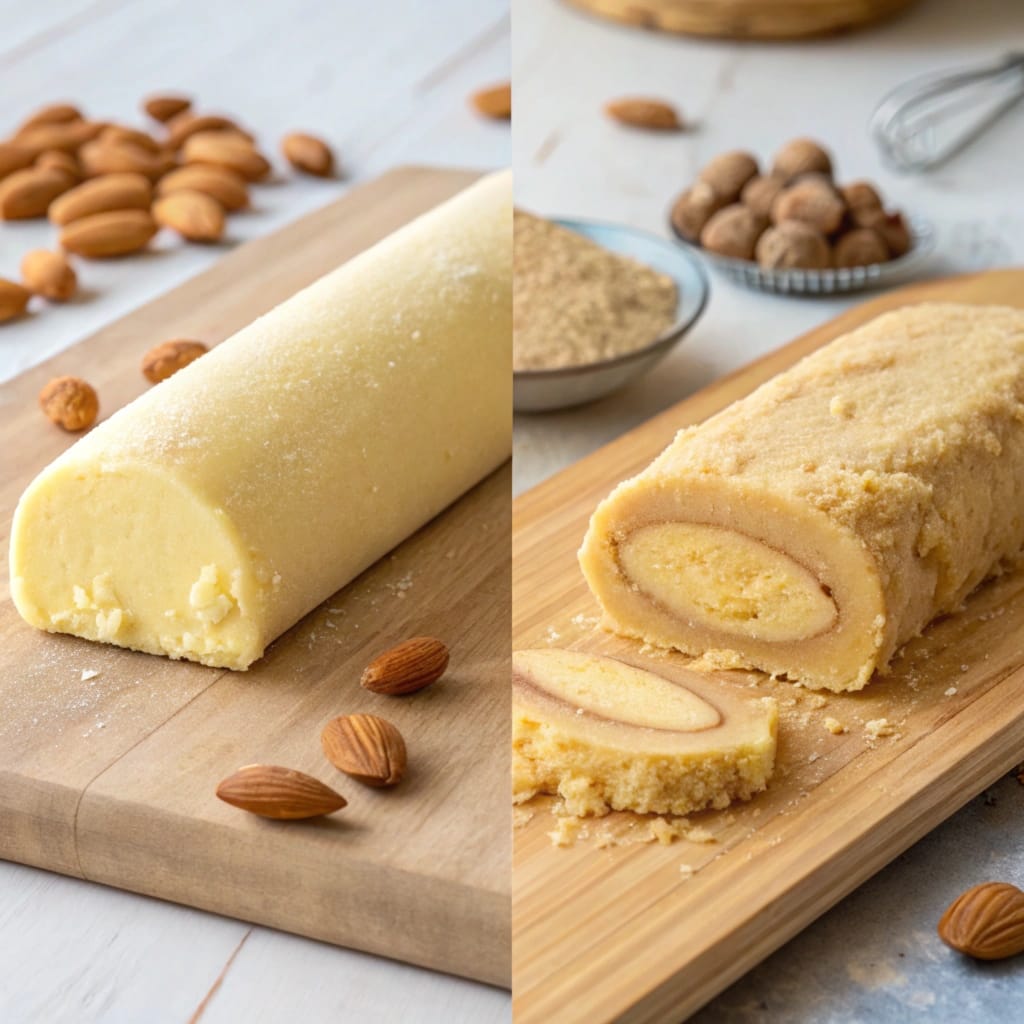If you’ve ever dabbled in baking, you’ve likely come across marzipan and almond paste in recipes for cakes, pastries, and holiday treats. At first glance, these two ingredients might seem interchangeable. Is there a difference between marzipan and almond paste? After all, both are made from almonds, and they even look somewhat similar. But as any experienced baker will tell you, marzipan and almond paste have distinct differences that can affect the taste, texture, and outcome of your desserts.
Understanding the difference between marzipan and almond paste is crucial if you want to get your baking just right. Each ingredient has its own unique properties that make it better suited for certain types of recipes. Marzipan is often used for decorating cakes and making edible figurines, while almond paste is commonly used as a filling for pastries and baked goods. But why is this the case?

Table of contents
What is Marzipan?
Definition of Marzipan
Marzipan is a smooth, moldable confection made from ground almonds, sugar, and sometimes egg whites or corn syrup. Its high sugar content gives it a sweet, nutty flavor and a pliable texture, making it ideal for cake coverings, edible figurines, and candy-making. Unlike almond paste, marzipan is much sweeter and smoother, making it perfect for decorative purposes.
One of marzipan’s most well-known uses is as a topping for fruitcakes, Christmas cakes, and wedding cakes, where it creates a smooth base for fondant or icing. It’s also used to make edible shapes and figurines, such as fruits, animals, and seasonal holiday treats.
Fun Fact: Marzipan originated in the Middle East and became popular in European desserts, especially in Germany, where Lübeck is renowned for its high-quality marzipan.
Key Ingredients of Marzipan
Marzipan’s signature texture and sweetness come from its simple but effective ingredient list:
- Ground Almonds: Provides a nutty flavor and forms the base of marzipan. The almonds are finely ground for a smooth finish.
- Sugar: Makes up about 50% of marzipan, giving it its signature sweetness and pliability.
- Egg Whites (Optional): Used as a binding agent to make marzipan firmer and smoother.
- Corn Syrup or Rosewater (Optional): Adds moisture and flavor, making it more pliable and easier to mold.
These ingredients are combined into a smooth dough, which can be rolled, molded, or shaped as needed for baking or decoration.
How Marzipan is Made
Making marzipan at home is easy and requires only a few ingredients. Here’s a quick guide:
- Grind the Almonds: Blanch and grind almonds into a fine powder.
- Add Sugar and Liquid: Mix in powdered sugar, egg whites, and water or syrup for moisture.
- Blend Until Smooth: Blend everything in a food processor until a smooth, dough-like consistency forms.
- Shape and Store: Roll, mold, or store marzipan in an airtight container to prevent it from drying out.
Pro Tip: Achieving the right consistency is key. Too much liquid makes it sticky, while too little makes it dry and crumbly.
Common Uses of Marzipan
Marzipan’s versatility makes it a popular choice for cakes, candy, and edible decorations. Here are its most common uses:
- Cake Covering: Used as a smooth, moldable layer for fruitcakes, wedding cakes, and Christmas cakes, often topped with fondant or icing.
- Edible Decorations: Molded into small fruits, flowers, and holiday-themed figurines, used as cake toppers or party favors.
- Sweets and Candy: Formed into bite-sized treats, sometimes dipped in chocolate or dusted with cocoa powder.
- DIY Baking Projects: Home bakers use marzipan for custom cake toppers or handmade edible gifts.
Marzipan’s sweet taste, pliability, and smooth texture make it essential for creative, artistic baking projects and professional cake designs.
What is Almond Paste?
Definition of Almond Paste
Almond paste is a thick, grainy mixture made from ground almonds and sugar. It has a higher almond-to-sugar ratio than marzipan, giving it a bolder almond flavor and a coarser, denser texture. Unlike marzipan, almond paste isn’t moldable and works best as a filling for pastries, cookies, and baked goods rather than as a decorative topping.
Almond paste is a staple in traditional European desserts, especially in French, Dutch, and Italian baked goods. It’s often used in frangipane tarts, almond croissants, and speculaas cookies.
Fun Fact: In the Netherlands, almond paste is used in Kerststol (Christmas bread) and Banketstaaf, while in Italy, it’s a key ingredient in classic Amaretti cookies.
Key Ingredients of Almond Paste
Almond paste has fewer ingredients than marzipan, but the ratios make a big difference.
- Ground Almonds: Coarsely ground for a thicker, grainier consistency.
- Sugar: Used in smaller amounts than in marzipan, giving it a richer almond flavor.
- Water or Syrup (Optional): Adds moisture and helps bind the ingredients together.
- Preservatives (Optional): Used in commercial almond paste to extend shelf life.
The higher almond content in almond paste results in a stronger, nuttier flavor and a dense, dough-like texture, perfect for fillings and batters.
How Almond Paste is Made
You can make almond paste at home in just a few steps. Here’s how:
- Grind the Almonds: Use blanched almonds (without skins) and grind them into a coarse powder.
- Add Sugar and Liquid: Mix in powdered sugar, water, or syrup to bind the ingredients. You can also add almond extract for more flavor.
- Blend It: Blend until a thick, grainy paste forms. It should be pliable but not sticky.
- Store It: Wrap in plastic or place in an airtight container to keep it fresh. Store it in the fridge for up to 2 weeks or freeze it for later use.
Pro Tip: If the paste is too dry, add a teaspoon of water or syrup to soften it. If it’s too sticky, add a bit more sugar.
Common Uses of Almond Paste
Almond paste is widely used in European baking, especially for its bold almond flavor and crumbly texture. Here are some of its most popular applications:
1. Pastry and Croissant Fillings
Almond paste is a key filling for almond croissants, Danish pastries, and bear claws. It melts slightly during baking, creating a soft, gooey filling with a rich almond flavor.
2. Traditional Holiday Breads
During the holiday season, almond paste is used to fill European breads like Stollen (Germany), Kerststol (Netherlands), and Banketstaaf (Netherlands), giving them a sweet, flavorful core.
3. Cookies and Bars
Almond paste is essential for making Amaretti cookies (Italy) and Speculaas (Netherlands). It’s also a key ingredient in almond macaroons and chewy almond bars.
4. Cakes and Tarts
Frangipane tarts use almond paste blended into a custard-like filling, which pairs beautifully with fruits like pears and cherries. Almond paste is also mixed into cake batters to add moisture, flavor, and richness.
5. Custom Confections
While almond paste is mostly used for fillings, it can also be sweetened and shaped into small confections similar to marzipan-style sweets.
Key Differences Between Marzipan and Almond Paste
Marzipan and almond paste may look alike, but their ingredients, texture, sweetness, uses, and cost set them apart. Knowing these differences is essential when deciding which one to use in your baking. Here’s a quick comparison of their most important features.
Ingredients
The key difference lies in the almond-to-sugar ratio.
- Marzipan: Contains more sugar (2 parts sugar to 1 part almonds), making it sweeter and more moldable. Other ingredients like egg whites or corn syrup help create a smooth, dough-like consistency.
- Almond Paste: Has a higher almond content (about 1:1 ratio with sugar), giving it a stronger almond flavor and thicker texture. Water, syrup, or almond extract may be added, but no egg whites.
Summary: Marzipan is sweeter and more pliable, while almond paste is nuttier, denser, and less sweet.
Texture
Their textures affect how they are used in cooking and baking.
- Marzipan: Smooth, soft, and moldable like fondant or clay. It can be rolled, molded, and shaped into cake toppers, edible figures, and decorations.
- Almond Paste: Coarse, crumbly, and dense. It’s not pliable and cannot be molded, but it blends well into batters and fillings.
Summary: Marzipan is smooth and moldable, making it perfect for cake decorations. Almond paste is thicker and grainier, ideal for fillings.
Sweetness
Their sweetness depends on sugar content.
- Marzipan: Very sweet (up to 70% sugar) with a candy-like taste. Its sweetness makes it great for cake coverings and edible treats.
- Almond Paste: Less sweet due to more almonds and less sugar. Its rich, nutty flavor is perfect for blending into batters and fillings.
Summary: Marzipan is sweeter and often eaten on its own, while almond paste provides a stronger almond flavor in baked goods.
Uses in Baking and Cooking
Their unique textures and flavors make them ideal for different purposes.
- Marzipan: Best for cake coverings, candy-making, and edible decorations. It’s often rolled out to cover fruitcakes, Christmas cakes, and wedding cakes. Marzipan is also molded into shapes like fruits, animals, or flowers.
- Almond Paste: Used as a filling in pastries, croissants, and holiday breads. It also serves as a base for frangipane tarts, Danish pastries, and amaretti cookies.
Summary: Use marzipan for decorations and candy. Use almond paste for fillings, cookies, and baked goods.
Cost and Availability
Price and availability can affect which product you choose.
- Marzipan: More expensive due to higher sugar content and the extra processing required to create a smooth, moldable texture. It’s commonly found in grocery store baking aisles, especially during the holiday season.
- Almond Paste: More affordable, but availability can vary. It’s usually sold in cans, tubes, or vacuum-sealed packages in the baking or international foods aisle.
Summary: Marzipan costs more and is easier to find during holidays, while almond paste is cheaper but sometimes harder to locate in stores.
Can They Be Used Interchangeably?
Not always.
- When You Can Substitute: Marzipan can replace almond paste as a filling, but you’ll need to reduce the sugar in the recipe since marzipan is sweeter.
- When You Can’t Substitute: Almond paste cannot be used as a cake covering or for making edible figures. It’s too coarse and crumbly, while marzipan is smooth and pliable.
Pro Tip: To make almond paste act like marzipan, mix it with powdered sugar and egg white to create a smoother, moldable consistency.
Summary of Key Differences
| Feature | Marzipan | Almond Paste |
|---|---|---|
| Texture | Smooth, pliable, moldable | Coarse, crumbly, thick |
| Sweetness | Sweeter (more sugar) | Less sweet (more almonds) |
| Uses | Cake covering, edible figures | Fillings for pastries, cookies, and bread |
| Ingredients | Almonds, sugar, egg whites | Almonds, sugar, water/syrup |
| Cost | More expensive | More affordable |
| Availability | Easily available in stores | May be harder to find |

Frequently Asked Questions (FAQs) About Is there a difference between marzipan and almond paste?
Can I use almond paste instead of marzipan?
Yes, but it depends on the recipe.
- When It Works: Almond paste can replace marzipan as a filling for pastries, croissants, and cakes. However, since marzipan is sweeter, you may need to reduce the sugar in your recipe.
- When It Doesn’t Work: For cake coverings or edible decorations, almond paste is not a good substitute. It’s too grainy and crumbly to be rolled or molded like marzipan.
Pro Tip: You can make almond paste more like marzipan by blending in powdered sugar and egg white to create a smoother, sweeter dough.
Why is marzipan more expensive than almond paste?
Marzipan costs more due to its ingredients and production process.
- Higher Sugar Content: Marzipan has more sugar and requires more processing to achieve its smooth, moldable texture.
- Use in Premium Products: Marzipan is used for decorations, edible figurines, and cake toppers, which increases its perceived value.
Almond paste, on the other hand, is simpler to produce, as it has a coarser texture and requires fewer processing steps.
Can you eat almond paste raw?
Yes, almond paste is safe to eat raw, but it’s less sweet and more intense in flavor than marzipan.
- Texture and Taste: It’s coarser and less sweet than marzipan, so it’s better used as a filling for baked goods rather than eaten plain.
- How to Enjoy It: Instead of eating it raw, blend it into cookie dough, cake batter, or pastry fillings for a delicious nutty flavor.
Marzipan, being sweeter and smoother, is often eaten raw as candy or molded into edible decorations.
What desserts use marzipan vs. almond paste?
Both marzipan and almond paste are used in desserts, but their roles are different.
Desserts that Use Marzipan
- Cakes: Coverings for fruitcakes, Christmas cakes, and wedding cakes.
- Decorations: Molded into edible fruits, flowers, and figurines for cake toppers.
- Sweets: Shaped into candies, sometimes dipped in chocolate.
Desserts that Use Almond Paste
- Pastries: Fillings for almond croissants, Danish pastries, and bear claws.
- Cookies: Key ingredient in amaretti cookies and almond macaroons.
- Holiday Breads: Used in European Christmas breads like Stollen and Banketstaaf.
Summary: Use marzipan for decorations and coverings, and use almond paste for fillings and baking.
Does almond paste taste the same as marzipan?
No, marzipan and almond paste taste different.
- Marzipan: Sweet, candy-like, with a mild almond flavor.
- Almond Paste: Rich, bold almond flavor with less sweetness.
Marzipan is often eaten as candy, while almond paste is used to add intense almond flavor to baked goods.
How long can marzipan and almond paste be stored?
Both marzipan and almond paste have a long shelf life if stored properly.
- Marzipan: Unopened, it lasts for 6 months. Once opened, wrap it tightly and store it at room temperature for 2-3 months or refrigerate it to keep it fresh longer.
- Almond Paste: Unopened, it lasts for 6-12 months. Once opened, refrigerate it for up to 3 months, or freeze it for up to 6 months.
Pro Tip: If marzipan or almond paste dries out, knead in a few drops of water or syrup to restore its texture.
Can I make marzipan and almond paste at home?
Yes! Both marzipan and almond paste are easy to make at home.
- Homemade Marzipan: Blend 2 cups almond flour, 1 cup powdered sugar, 1 egg white, and 1 teaspoon almond extract. Knead it into a smooth dough.
- Homemade Almond Paste: Blend 1 cup blanched almonds, 1/2 cup sugar, and 1-2 tablespoons water in a food processor until a thick paste forms.
Homemade versions are fresh, customizable, and often more flavorful than store-bought.
Are marzipan and almond paste gluten-free?
Yes, both marzipan and almond paste are naturally gluten-free.
- Marzipan: Made with almonds, sugar, and sometimes egg whites — all gluten-free ingredients.
- Almond Paste: Contains almonds, sugar, and water, none of which have gluten.
Caution: Check for cross-contamination in store-bought versions, as some brands may process these products in facilities that handle gluten-containing items.
More Ideas
If you found this guide on marzipan and almond paste helpful, here are some more delicious and insightful articles you may enjoy. Whether you’re looking to expand your baking skills or explore new recipes, these ideas will spark your creativity.
1. Recipes and Baking Tips
- Almond Nut Cake Recipe — Discover how to make a rich, nutty almond cake that pairs perfectly with marzipan decorations.
- Baking with Almond Flour — Learn how almond flour can elevate your baking and why it’s a great alternative for gluten-free treats.
- Secret to Super Moist Cake — Want your marzipan-covered cakes to stay moist? This guide reveals pro tips for achieving the perfect cake texture.
- What Flavor Goes Well with Almond Cake? — Looking for flavor pairings for your almond-based desserts? This guide will inspire your next baking project.
2. Explore More Unique Recipes
- What is Chicken Salad Chick Made Of? — Curious about the ingredients behind this famous chicken salad? Get the inside scoop.
- Chicken Salad Chick Broccoli Salad Recipe — A refreshing and healthy side dish to pair with your sweet almond-based desserts.
- Easy Pastalaya Recipe — Take a break from sweets with this easy one-pot pastalaya recipe.
- Is Pastalaya Healthy? — Thinking of switching up your weekly meals? Find out if pastalaya fits into your healthy eating plan.
Conclusion
Marzipan and almond paste may share some similarities, but their differences are crucial for bakers, pastry chefs, and dessert lovers alike. Marzipan is sweet, smooth, and moldable, making it ideal for cake coverings, edible decorations, and candy-making. On the other hand, almond paste is coarser, richer in almond flavor, and less sweet, which makes it the perfect filling for pastries, cookies, and tarts.
When deciding which one to use, think about the role it plays in your recipe. If you’re decorating a fruitcake or crafting edible cake toppers, marzipan is your best choice. But if you need a rich, nutty filling for a Danish pastry, croissant, or frangipane tart, almond paste is the way to go.
You now have a clear understanding of their ingredients, textures, sweetness, and baking applications. Whether you’re molding marzipan into charming holiday figures or blending almond paste into a gooey croissant filling, you’ll be able to select the right ingredient with confidence.
